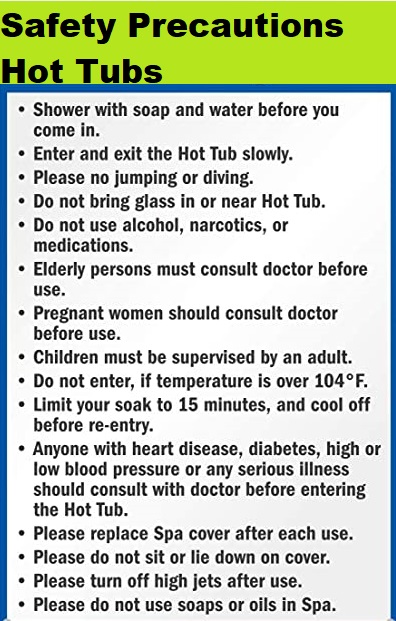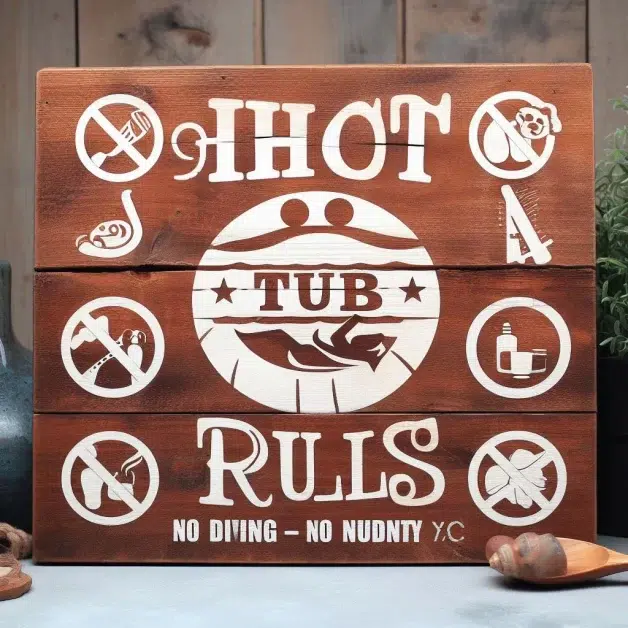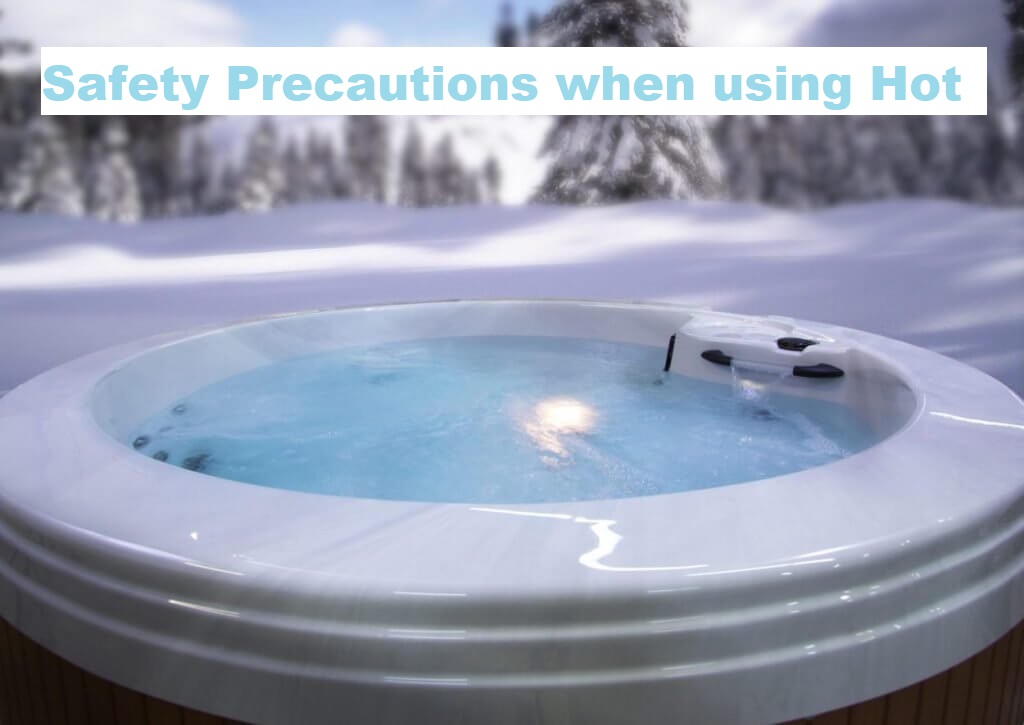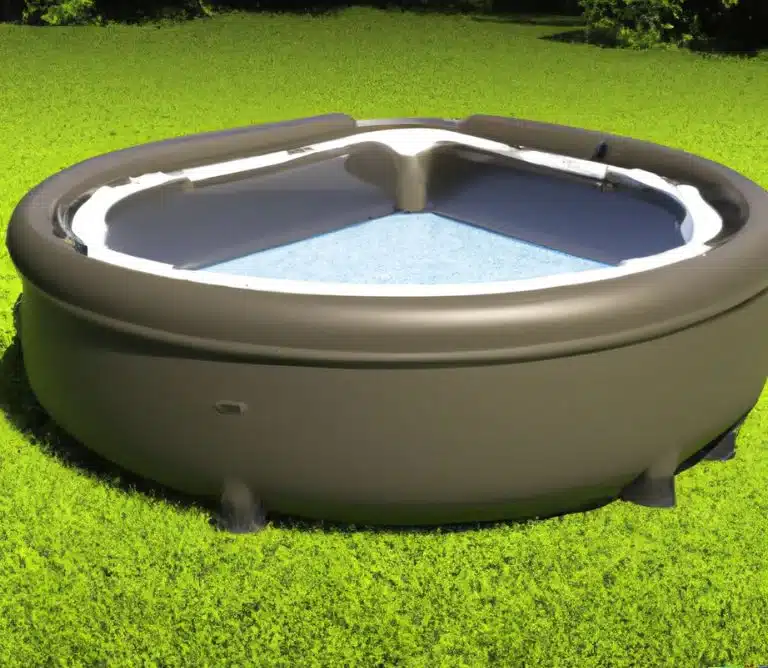15 Safety Precautions When Using Hot Tubs
Enjoy hot tubs safely. Follow these 15 essential hot tub safety tips on water temperature, chemicals, alcohol, children, health conditions, and more for a relaxing soak without risk.
Using a hot tub can be a relaxing and enjoyable experience, but it’s important to prioritize safety before you dive in. Here are some key precautions to remember:
General Safety:
- Temperature: Keep the water temperature below 104°F (40°C). Higher temperatures can lead to overheating, dizziness, and even heat stroke. Be extra cautious if you have any health conditions.
- Time limit: Limit your soak time to 10-15 minutes, especially if it’s your first time. Listen to your body and get out if you feel unwell.
- Hydration: Drink plenty of water before, during, and after your soak to prevent dehydration. Avoid alcohol, which can dehydrate you further.
- Cleanliness: Maintain proper water sanitation by regularly testing and adjusting pH and chlorine/bromine levels. Shower before and after using the hot tub to prevent contamination.
- Supervision: Never leave young children unattended in or around the hot tub. Children under 5 should not use hot tubs at all.
- Slip and fall: Be cautious of wet surfaces. Use non-slip mats and handrails to prevent falls.
Health and Medical:
- Consult your doctor: If you have any health conditions, especially heart disease, high blood pressure, or diabetes, consult your doctor before using a hot tub.
- Pregnancy: Pregnant women should consult their doctor before using a hot tub, especially in the first trimester.
- Medications: Certain medications can interact with hot tub use, so check with your doctor if you’re taking any medications.
- Open wounds: Avoid using the hot tub if you have any open wounds or infections.
Additional Tips:
- Keep your head above water: Avoid submerging your head to prevent getting your hair caught in the suction outlets.
- Don’t use alone: Have someone else nearby if you need help.
- Store chemicals safely: Keep pool and hot tub chemicals out of reach of children and pets.
- Check the cover: Ensure the cover is securely on when the hot tub is unused.
- Maintenance: Follow the manufacturer’s instructions for properly maintaining your hot tub.
- Following these safety precautions allows you to enjoy your hot tub experience safely and responsibly. Remember, safety comes first!
Typical Safety precautions you should take when using hot tubs:
A hot tub can be a comfy and enjoyable experience, but keeping safety in mind is important. Here are essential precautions to follow:
- Keep the water temperature under 104°F (40°C) to avoid overheating. Higher temperatures can be dangerous.
- Children under 5 should not use hot tubs because of health risks.
- Secure the hot tub’s safety cover when not in use to prevent accidents.
- Pregnant ladies should confer with their doctor before utilizing a hot tub, especially in the first trimester.
- Shower with soap and water before entering to avoid introducing contaminants.
- Avoid using the hot tub if you have diarrhea or an infectious disease.
- Avoid ingesting harmful bacteria by swallowing hot tub water or getting it in your mouth.
- Follow posted maximum occupancy limits to allow proper disinfection.
- Refrain from drinking alcohol before or during hot tub use, as it can be dangerous.
Don’t Let the Fun End in Tragedy
You probably know the basics: Hot tubs and spas can be a relaxing way to enjoy your downtime. But there are some safety tips that you need to know before jumping in.
But if you don’t follow these hot tub safety tips, it could lead to serious injury or even death! So please take note of this list of important 15 Safety Tips When Using Hot Tubs points, and share them with your friends who like to soak too.

- STAY HYDRATED
Hydrating yourself is important before using the hot tub, and also while you are inside one! If you maintain proper hydration, it has the potential to avert the occurrence of muscle cramps. But if you don’t drink enough water leading up to a hot tub session, it can cause nausea and sometimes even fainting. - KEEP IT CLEAN
It’s important to keep the hot tub clean so that you can stay healthy while using it! This means not allowing people with cuts or open wounds in the water unless they have been properly disinfected. Sharing your hot tub is fine, but this can spread things like yeast infections and certain STDs. - DON’T SET YOUR DRINK DOWN
Don’t set your drink down in the hot tub! When you venture forth, be wary of losing its trail effortlessly, for the last thing you desire is to forsake its memory upon your departure. Swimming in such conditions not only presents a potential drowning risk to other individuals in the vicinity, but it also endangers the safety of any children residing within your household. - LIMIT ALCOHOL AND DRUGS
As previously discussed, it is imperative to ensure adequate hydration by consuming ample amounts of water during your hot tub session. But if you do choose to indulge in a few alcoholic beverages it’s also important to know how much is too much! Consuming beverages while in the hot tub can accelerate dehydration, heightening the risk of fainting. Also, mixing alcohol with hot tub chemicals is dangerous and shouldn’t be done. - NO ELECTROCUTION ALLOWED
When installing a hot tub in your backyard, it is crucial to exercise caution and avoid any contact or interference with electric lines to ensure safety. It should have its power source, but if that’s not an option you need to call a professional to make sure the hot tub is correctly wired. - NO FIREWORKS
We get it: fireworks are exciting and fun to watch. However, they pose a serious threat when inside a hot tub because people might not see them while the lights are off. There is also a high likelihood that some of the sparks will fall into your tub, starting a fire. - KEEP AN EYE OUT FOR CHILDREN AND PETS
There is no such thing as responsible hot tubbing while there are children or pets in your home. Your attention should be squarely on them at all times. Ensure that all your chemicals are securely locked up. If the lid isn’t on tight enough it can come off and create a chemical spill. - NO HORSEPLAY
Make sure there’s no horseplay inside the hot tub! It’s easy to accidentally slip and fall if someone gets you wet or pushes you. You do not want to have a serious accident because you were wrestling or fooling around. Even worse, slip-and-fall accidents can become deadly when the chemicals mix with water. - DON’T LEAVE YOUR DRINK BEHIND
Don’t leave your drink unattended in the hot tub! It’s so easy to forget that it’s there. This not only presents a drowning risk for anyone else using it but also for any children in your household. - NO SCALDING GETAWAYS!
If something happens and the water becomes too hot, don’t try to jump out! Instead, turn the jets off so the water level goes down. Then you can gradually exit the water and ensure that it is no longer excessively hot before getting back in. - DON’T LEAVE THE HOT TUB UNATTENDED
A lot of people choose to turn off the lights and soak in darkness, but this can be very dangerous! You should never leave the hot tub unattended, as that’s when injuries can happen. The dark can also attract people who you don’t want near the water. - DON’T DRINK AND DRIVE…OR HOT TUB
If you’ve been out drinking but still want to soak in the tub, it might be a good idea to find a sober friend or designated driver to take you home. There’s a good chance that your balance and ability to make quick decisions are severely impaired after one too many beers. - DON’T BRING THE HOT TUB INDOORS
Despite how tempting it might be, never bring a hot tub indoors! Using it indoors can be even more hazardous than using it in the backyard due to the presence of a higher concentration of chemicals in the mixture. Not only will you incur additional expenses on chemicals, but you could also encounter an electrical issue that could result in a fire. - NEVER IGNORE YOUR INSTINCTS
If something doesn’t feel right about your hot tub, don’t ignore it! Trust your instincts and prioritize caution. It is preferable to sacrifice some sleep than to risk losing a life. - HOT TUB BEFORE WORK, NOT AFTER!
While it might appear tempting to bring work home and check your emails while in the hot tub, this can pose significant dangers for multiple reasons. Firstly, there is a risk of your device accidentally falling into the water. Secondly, it might get damaged by water or chemicals. Finally, you don’t want to be focused on work while relaxing with friends and family.
Protect Your Health: Is Low Alkalinity In Hot Tub Dangerous
Negative effects of hot tubs
Hot tubs are often seen as a luxurious way to relax, but there are some potential negative health effects of using them.
- First, hot tubs can raise your body temperature and cause you to become dehydrated. This is especially true if you spend a lot of time in the hot tub or if the water is boiling.
- Second, hot tubs can increase your risk of skin cancer. The heat and chemicals in the water can damage your skin and make it more susceptible to cancer.
- Finally, using a hot tub may increase your risk of getting a urinary tract infection. The warm water can create an environment that allows bacteria to grow more easily, leading to an infection.
- If you decide to use a hot tub, be sure to take precautions to avoid these negative health effects.
Hot tub rules sign
Before purchasing or installing a hot tub, it is essential to be aware of some key information. Foremost, it is imperative to consistently abide by the manufacturer’s guidelines on usage and installation.
Moreover, take the time to familiarize yourself with any relevant local ordinances or regulations set by your homeowner’s association that may pertain to hot tub usage. Lastly, prominently display clear and concise signage outlining the hot tub rules to ensure that all users are aware of the expected behavior.

Hot tub dangers high blood pressure
A study disseminated in the esteemed journal Hypertension divulged that immersing oneself in a balmy hydrotherapy tub markedly elevates the levels of arterial pressure in individuals afflicted with hypertension.
The erudite researchers ascribe this notable consequence to the thermal emanations engendered by the hydrotherapy tub, thereby instigating the discharge of adrenaline within the corporeal domain, subsequently culminating in an upsurge in systolic and diastolic blood pressure.
Hot Tubs and Heart Health: A Cautionary Perspective
Recent studies have highlighted potential risks for individuals with heart problems when using hot tubs. Research involving over 30,000 participants found a correlation between hot tub use and an increased risk of heart attacks or strokes. This is particularly concerning for those with pre-existing cardiovascular conditions, as the hot water can elevate heart rate and blood pressure, posing additional strain on the heart.
Safety Tips for Heart Patients Considering Hot Tub Use:
- Consultation is Key: Always discuss with your healthcare provider before using a hot tub, as they can offer tailored advice based on your condition.
- Limit Your Time: To reduce potential risks, keep hot tub sessions short.
- Listen to Your Body: Be vigilant about how you feel during hot tub use and exit the water if you experience any discomfort.
For more safety tips, check out the Mayo Clinic’s advice on using hot tubs safely with heart disease.
For further reading on heart health, visit the National Heart, Lung, and Blood Institute.
CDC guidelines for hot tubs
The Centers for Disease Control and Prevention (CDC) has released new guidelines for hot tubs to help reduce the spread of germs and illnesses. According to the CDC, hot tubs should be cleaned and disinfected after each use, and people should avoid drinking the water or swallowing any suds.
In addition, people with open wounds should not enter a hot tub. Healthcare provider recommendations The American Academy of Family Physicians (AAFP) says that people with heart disease or high blood pressure should not use hot tubs.
They should also be careful about using a hot tub if they have any skin conditions, such as eczema or psoriasis.
Are hot tubs good for arthritis?
A definitive consensus regarding the beneficial effects of hot tubs on arthritis remains elusive, although numerous individuals afflicted with the condition attest to experiencing relief through their utilization.
Hot tubs possess the potential to enhance blood circulation and mitigate inflammation, both of which play pivotal roles in managing symptoms associated with arthritis.
Nonetheless, it is imperative to seek counsel from a medical professional before engaging in hot tub usage if one is afflicted with arthritis, as prolonged exposure to heated water may entail certain risks.
Do hot tubs cause cancer?
This question lacks a conclusive response. The World Health Organization has not classified the utilization of hot tubs as a carcinogen, yet they have not dismissed the possibility either. The existing studies on this matter present inconclusive findings. Certain research suggests that particular chemicals, including chlorine, found in hot tubs, may possess carcinogenic properties.
However, other studies assert that hot tub users do not face an elevated risk of cancer.
To achieve a hot tub without itchiness, it’s important to pay attention to water chemistry. Regularly test and balance the hot tub water to ensure the correct pH, alkalinity, and sanitizer levels.
Final Words:
Safety precautions are always important when using hot tubs. If you find yourself uncertain about the recommended best practices or experience any safety-related concerns, please feel free to contact us without hesitation. We are here to provide personalized guidance and assistance to ensure your safety while enjoying your hot tub.
For additional information, visit Hot Tub Patio, or if you’re interested in more reading, see our Hot Tub Water Care Guide.
Common Queries:
What is the maximum temperature of a hot tub? The maximum temperature of a hot tub is usually 106 C (221 F).
What distinguishes a hot tub from a jacuzzi? Stay calm and avoid confrontation. If you are being attacked, defend yourself with whatever is available.
Try to get away from the attacker if possible. Remember, it is never okay to physically resist an attack or threaten someone with violence.
What diseases can be transmitted in a hot tub? Some diseases can be transmitted in a hot tub, so it’s important to take safety precautions. One of the biggest risks is Legionnaires’ disease, which is caused by bacteria that grow in warm water. People can get Legionnaires’ disease by breathing in mist or vapor from the water. Another risk is intestinal infections, which can be caused by swallowing contaminated water.
Which diseases are transmitted in a hot tub? People can get Legionnaires disease by breathing in mist or vapor from the water. Another risk is intestinal infections, which can be caused by swallowing contaminated water.
How do you keep the water in a hot tub clean? Cleaning the hot tub by using mild soap and water will work to remove dirt. However, it’s best to use a commercial cleaning product designed for swimming pools or spas.
What chemicals can a hot tub use to disinfect the water? The prevailing disinfectants employed in hot tubs are primarily chlorine and bromine.













11 Comments